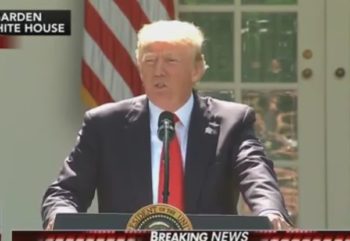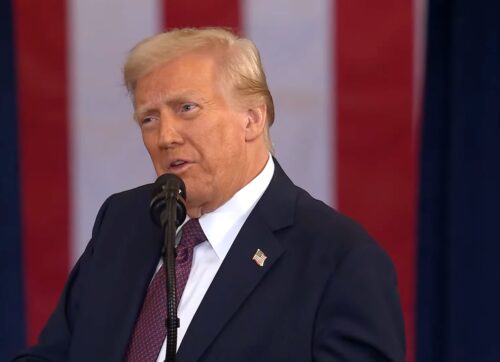
“Tony Blair is contemplating an unprecedented rift with the U.S. over climate change at the G8 summit next week, which will lead to a final communiqué agreed by seven countries with President George Bush left out on a limb,” the Guardian reported of the meeting at Gleneagles, Scotland. France and Germany preferred an unprecedented split communiqué to a weak one, the article said.
George W. Bush, who had pulled the country out of the Kyoto Protocol in 2003, blinked and agreed to an official document that affirmed global warming was occurring and that “we know enough to act now.”
The 2005 G8 put the United States back on the path that ultimately led through the Copenhagen climate summit—when China and India thwarted U.S.-led attempts at a global climate treaty—to the Paris Agreement 11 years later.
There was a very different American president this June at the Charlevoix G7 (as it has been since Russia’s suspension in 2014).
Had it not been for the row with Justin Trudeau, when the Canadian prime minister responded to President Trump’s steel and aluminum tariffs with retaliatory tariffs of his own, the big story would have been the climate split.
Where 15 years ago the mere possibility of isolation pushed Bush to compromise, Trump embraced the isolation and inserted an America-only paragraph into the summit communiqué outlining a position fundamentally contradicting the rest of the group’s.
“The United States believes sustainable economic growth and development depends on universal access to affordable and reliable energy resources,” it reads, going on to offer a manifesto for global energy realism.
That single paragraph is more definitive than the president’s announcement last August that the United States would be withdrawing from the Paris treaty.
After all, George W. Bush nixed the Kyoto Protocol that Bill Clinton signed. And Trump, when announcing the Paris withdrawal, left the door open to U.S. participation in a renegotiated climate deal. At Charlevoix, he closed it. Unlike in 2005, it’s very hard now to see any way back.
This is about far more than process. Trump is breaking the spell of the inevitability of the transition to renewable energy. The impression of irresistible momentum has been one of the most potent tools in enforcing compliance with the climate catechism.
Like socialism, the clean-energy transition will fail because it doesn’t work. But it requires strong leadership to avoid the ruin that will disprove the false promise of cost-free decarbonization.
That reality is already hurting those countries that are farther down the renewable-energy path of ruin than the United States—and, when offered the chance, voters are taking it out on politicians.
In March, a fanatically pro-wind and solar energy Labor government in South Australia, one of the eight states and territories that make up the country, decided to make the state elections a referendum on renewable energy.
With some of the world’s most expensive electricity and a serious blackout in 2016, South Australia voters kicked out Labor and voted in a government vowing to repeal the state’s renewable energy target.
Days before Justin Trudeau took the center of the global stage as host of the G7 summit, his Liberal party was trounced in provincial elections in Ontario.
The province’s party had won four consecutive terms in office and had pressed virtually every pro-renewable, anti-hydrocarbon policy imaginable. In the June 7 elections, they took just seven seats in the 124-seat legislature.
“I made a promise to the people that we would take immediate action to scrap the cap-and-trade carbon tax and bring their gas prices down,” newly elected premier Doug Ford announced.
Nowhere has a confrontation with the physical and economic realities of renewable energy been more painful than Germany, the birthplace of renewable-energy ideology.
As party leaders negotiated a new coalition agreement after the September 2017 elections, they acknowledged for the first time that Germany was going to miss the sacrosanct 2020 target to cut greenhouse gas emissions by 40 percent from 1990 levels.
This had been set in 2007, and the first 20 percent had been easy. Thanks to German reunification, former East Germany had seen its industries collapse, and there were plenty of inefficient power stations to close.
It had always been clear, Angela Merkel declared three weeks after the September federal elections, that it was not going to be easy to cut the other 20 percent “at a time of relatively strong economic growth.” Note: Stronger growth equals higher emissions.
Launching the German renewables transition in 2004, energy minister Jürgen Trittin promised that it would put no more than the cost of an ice cream on monthly electricity bills.
Nine years later, his successor, Peter Altmaier, admitted that the costs could amount to $1.34 trillion by the end of the 2030s.
At a meeting in June of E.U. energy ministers, Germany ran up the white flag. Altmaier shocked fellow E.U. energy ministers by rejecting higher renewable-energy targets.
“We’re not going to manage that,” he told them. “Nowhere in Europe is going to manage that. Even if we did manage to get enough electric cars, we wouldn’t have enough renewable energy to keep them on the road.”
No country has a greater abundance of hydrocarbon energy than the United States. The corollary is that no country was as big a loser from participating in the Paris Agreement and its intention to progressively decarbonize the world’s hydrocarbon superpower.
On July 10, the Energy Information Administration forecast that next year, the United States will produce 12 million barrels of oil a day and overtake Saudi Arabia to be the world’s number-one producer.
When it comes to the politics of energy, the interests of the United States and European green ideology are irreconcilable.
Donald Trump understands this. “Our country is blessed with extraordinary energy abundance, which we didn’t know of even 5 years ago and certainly 10 years ago,” the president said in 2017.
Those remarks were not only a paean to America’s energy resources, they were a full-dress rejection of the policies of his predecessor and of the Democrats’ goal of Europeanizing American energy policy.
We have nearly 100 years’ worth of natural gas and more than 250 years’ worth of clean, beautiful coal. We are a top producer of petroleum and the number-one producer of natural gas.
We have so much more than we ever thought possible. We are really in the driving seat. And you know what? We don’t want to let other countries take away our sovereignty and tell us what to do and how to do it.
That’s not going to happen. With these incredible resources, my administration will seek not only American energy independence that we’ve been looking for for so long, but American energy dominance.
And we’re going to be an exporter—exporter. We will be dominant. We will export American energy all over the world, all around the globe.
These energy exports will create countless jobs for our people, and provide true energy security to our friends, partners, and allies all across the globe.
For the first time since 1992, when George H.W. Bush went to the Rio Earth Summit, an American president was outlining a global energy strategy diametrically opposed to the tenets underlying the U.N. climate process.
Trump was establishing a rival pole based on energy realism and energy abundance.
The Rio Summit was the brainchild of Canadian Maurice Strong, and he understood that what most motivates political leaders, bureaucrats, and corporate CEOs is the fear of being left out.
“The process is the policy,” Strong said, and the annual climate conferences that have been held since the U.N. Framework Convention on Climate Change was adopted in Rio created a sense of irresistible momentum.
It’s that spell Trump is now breaking. Countries around the world are being damaged by the anti-hydrocarbon policies encouraged by the U.N., but leaving the Paris Agreement was a step only the United States was strong enough to take.
Now it is up to the Trump administration to help other countries act in their economic interests.
Energy secretary Rick Perry has talked of U.S. willingness to lead a global alliance of countries wanting to make fossil fuels cleaner rather than abandoning them.
Of the G7, Japan has traditionally been most leery of decarbonization, and after the 2011 Fukushima accident, Japan decided to expand its coal-fired generating capacity by half, building 45 new coal power stations.
Poland is another coal-based economy that has no intention of phasing out coal. Of all energy-realist nations, Poland is the one that sees eye to eye with the Trump administration.
During the Brezhnev years, Poland—alone of the Eastern Bloc nations—refused to sign up to sulfur-emission cuts designed to isolate the U.K. and the United States at the height of the acid rain scare.
As host of the next round of U.N. climate talks, at Katowice in December, Poland is more than usually important as a U.S. energy ally. Australia, the world’s largest coal exporter, is another obvious U.S. partner.
Where the United States can make the biggest difference, though, is with the developing nations who depend on overseas finance to build out their electrical grids and need the cheap, reliable energy only coal can supply.
Last September, Southeast Asian energy ministers, noting the rising use of coal in the region, called for greater promotion of clean coal.
In June, India struck a strategic energy partnership with the United States, described by Perry as an “amazing opportunity for U.S. energy” to sell clean coal, nuclear technology, oil, and gas.
Read rest at Weekly Standard



















The Kyoto Treaty just like the Paris Accord nothing but the usial B.S you can expect from world leaders pushing for a New World Order the same for the 1992